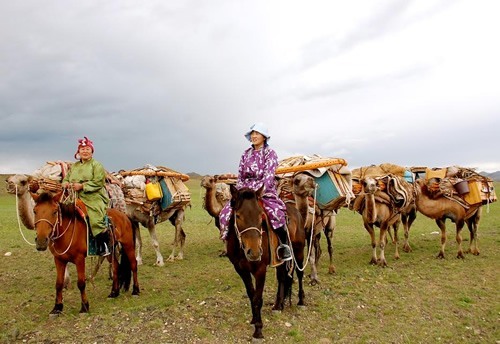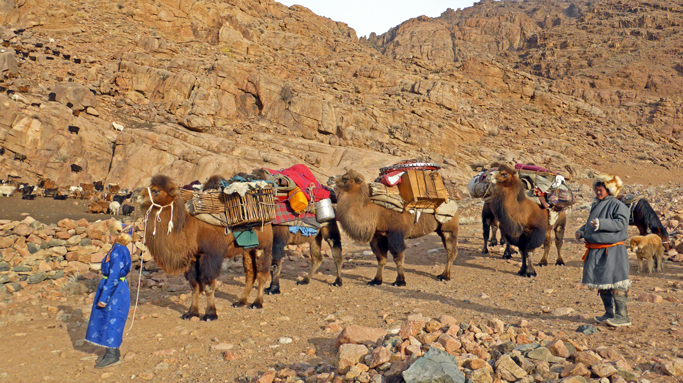Introduction
Mongolia is one of the few places left in the world where the traditional nomadic lifestyle is still alive. Far from modern cities and technology-driven routines, Mongolian nomads continue to move with the seasons, herding their livestock and living in gers (yurts) just as their ancestors did for centuries. For travelers seeking more than just sightseeing, this offers a rare opportunity to experience a way of life that feels authentic, untouched, and deeply connected to nature.

Staying with nomadic families in Mongolia allows visitors to go beyond the role of a tourist and truly immerse themselves in local culture. It’s a chance to live as the nomads do — sharing meals, sleeping in a traditional ger, helping with daily tasks, and learning firsthand about their values of hospitality, resilience, and harmony with the environment. For many, this isn’t just a trip; it’s a cultural journey that provides meaningful human connections and memories that last a lifetime.
Who Are the Mongolian Nomads?
The Mongolian nomads represent one of the last remaining true nomadic cultures in the modern world. Today, nearly a third of Mongolia’s population is still engaged in this centuries-old lifestyle, moving across the vast steppes to find fresh pasture and water for their herds. Unlike settled communities, nomadic families shift their homes four to six times a year, following the rhythm of the seasons. This seasonal migration is not only practical but also a way of life deeply rooted in the nomadic culture of Mongolia, ensuring the survival of both people and animals in a land of extreme climates.
Livestock lies at the heart of nomadic life. Families herd horses, camels, yaks, sheep, and goats, each animal serving a vital purpose: horses for transportation, camels for long desert journeys, yaks for carrying loads in the mountains, and sheep and goats for meat, wool, and cashmere. These animals are more than economic resources—they are a symbol of wealth, identity, and heritage. The bond between nomads and their herds illustrates a relationship of respect and interdependence, reflecting how Mongolians have thrived for centuries in one of the world’s most challenging environments.

Staying with Nomadic Families
For travelers who want more than a quick glimpse of rural life, a Mongolian ger stay offers a true cultural immersion. Many visitors connect with host families through local tour operators or community-based tourism initiatives that ensure benefits go directly to the nomads themselves. These programs not only create unforgettable travel experiences but also support the preservation of Mongolia’s nomadic traditions.
Living in a traditional ger (yurt) is central to this journey. Guests are welcomed into the circular felt-covered home, sharing the same space where families cook, eat, and sleep. The simplicity of ger life—heated by a wood or dung stove, lit by natural light, and surrounded by endless open landscapes—allows visitors to slow down and appreciate the beauty of a lifestyle in harmony with nature.
Food is another highlight of the nomadic family experience. Travelers are often invited to try homemade meals such as dairy products, freshly cooked meat dishes, and the famous airag (fermented mare’s milk), a national drink that symbolizes hospitality. Sharing food is more than nourishment—it’s an expression of respect and connection.
Guests are also encouraged to join in the family’s daily routines. You might help milk animals, ride horses across the steppe, herd sheep and goats, or simply spend time with the children. These simple but meaningful activities give travelers a hands-on understanding of nomadic resilience, resourcefulness, and hospitality—qualities that define life on the Mongolian steppe.
Activities Travelers Can Experience
One of the most rewarding aspects of authentic travel in Mongolia is the opportunity to take part in activities that are deeply rooted in nomadic life. These aren’t staged tourist shows but real experiences that families practice every day, offering travelers a genuine connection to the land and its people.
Perhaps the most iconic activity is horseback riding across the vast open steppe. Horses are central to Mongolian identity, and learning to ride alongside nomads provides both adventure and cultural insight. In the desert regions, visitors can also try camel riding, joining caravans that echo the ancient Silk Road routes.
Daily chores often become unique adventures for guests. Helping with milking animals and processing dairy products offers a glimpse into the self-sufficiency of nomadic households, where yogurt, cheese, and the famous airag are prepared by hand. Some travelers even get the chance to accompany families during seasonal migrations, joining a camel caravan or riding horses as the family moves to new pastures—a truly unforgettable Mongolia adventure travel experience.
Cultural immersion doesn’t stop at physical activities. Guests are often welcomed with traditional performances, from the haunting beauty of long song (urtiin duu) to the melodies of the morin khuur (horsehead fiddle). These art forms, passed down through generations, reflect the soul of the steppe and the harmony between humans and nature.
At night, the magic continues under one of the clearest skies in the world. Stargazing in the Gobi Desert or on the endless grasslands reveals constellations untouched by city lights, making evenings by the ger a peaceful and awe-inspiring highlight of the journey.
Why Choose Nomadic Lifestyle Experience?
In a world where tourism often feels commercialized, the nomadic lifestyle experience in Mongolia stands out as something truly meaningful. Travelers who choose this journey aren’t just observers—they become participants in a way of life that has changed little over centuries. This authenticity is what makes the experience so valuable. Guests form real connections with nomadic families, share in their daily routines, and step away from the distractions of modern life. For many, it becomes a kind of digital detox, allowing them to reconnect with nature, community, and themselves.
Another reason to embrace this experience is its role in promoting sustainable travel in Mongolia. Staying with local families directly supports their livelihood, helping them maintain traditional practices while adapting to modern challenges. Unlike large-scale mass tourism, this type of cultural immersion leaves a lighter footprint on the environment and ensures that income flows directly into rural communities.
Many programs are also part of community tourism in Mongolia, which means that travelers contribute not just to individual families but to the preservation of cultural heritage as a whole. By choosing this path, visitors help protect ancient traditions, encourage responsible travel practices, and sustain one of the last nomadic cultures on Earth.
Ultimately, the nomadic lifestyle experience is more than just a trip—it’s a chance to travel responsibly, create lasting bonds with local people, and become part of a global movement that values authenticity, sustainability, and cultural respect.
Practical Travel Tips
Preparing for a nomadic lifestyle experience requires a little more thought than a typical vacation, but the rewards are well worth it. Here are some essential Mongolia travel tips to make your journey smoother and more respectful.
What to Pack:
Mongolia’s climate is extreme, with hot summers and cold nights even in June. Bring layered clothing, sturdy boots for riding and walking, and a warm jacket for chilly evenings. Since there are few shops in rural areas, pack personal essentials like medicine, sunscreen, and reusable water bottles. Small gifts for host families—such as tea, fruit, or children’s toys—are appreciated gestures of kindness.
Cultural Etiquette:
Respect is at the heart of Mongolia’s culture etiquette. When entering a ger, avoid stepping on the threshold and always use your right hand when giving or receiving items. Never touch the central hearth or point your feet toward it, as the fire is considered sacred. Showing respect to elders, accepting food or drink when offered, and asking before taking photos are all simple ways to honor your hosts.
Best Time to Visit:
The best time to visit Mongolia is from June to September, when the weather is warm, pastures are green, and nomadic families are most active. This is also the season of festivals, including the famous Naadam Festival in July. For those who want a quieter experience, late spring and early autumn offer beautiful landscapes with fewer tourists.
By preparing well and respecting local traditions, travelers not only ensure a smooth trip but also deepen their connection with the people and culture they came to discover.
Frequently Asked Questions (FAQs)
Is Mongolia safe for tourists?
Yes, Mongolia is generally considered very safe for tourists. Crime rates are low in rural areas, and nomadic families are known for their hospitality and generosity. In cities, travelers should take normal precautions such as watching valuables in crowded areas. The main challenges are not crime but the country’s vast distances, unpredictable weather, and limited infrastructure—so planning ahead is important.
How do I book a stay with nomadic families?
The easiest way is through local tour operators or community-based tourism programs that connect travelers with authentic host families. Some families also partner with eco-camps or travel agencies to organize Mongolian ger stays. Booking in advance is recommended, especially during summer, but in many regions arrangements can also be made on-site with the help of local guides.
What is the cost of a nomadic lifestyle experience in Mongolia?
Prices vary depending on the length of stay and included services. On average, a nomadic family experience costs between $30–$60 USD per night, usually including accommodation in a ger, meals, and participation in family activities. Multi-day tours with transportation and guides can cost more, but they provide additional convenience for travelers exploring remote areas.
Do Mongolian nomads speak English?
Most nomadic families do not speak English, as their daily lives are centered on herding and local traditions. However, many hosts work with guides or tour operators who act as translators. Even without a shared language, communication is often possible through gestures, smiles, and shared activities, making the experience authentic and rewarding.
Conclusion
Living with Mongolian nomads is not just a trip—it’s a once-in-a-lifetime cultural journey. Unlike typical sightseeing tours, this experience allows travelers to step into an ancient way of life, share genuine moments with local families, and discover what it means to live in harmony with nature. From riding horses across the steppe to sharing homemade meals in a ger, every moment spent with nomadic hosts creates lasting memories and a deeper appreciation for Mongolia’s rich heritage.
For those seeking authentic, meaningful, and sustainable travel, a nomadic lifestyle experience is one of the most rewarding adventures you can take. It’s a journey that enriches both the traveler and the host community, ensuring that traditions continue to thrive in the modern world.